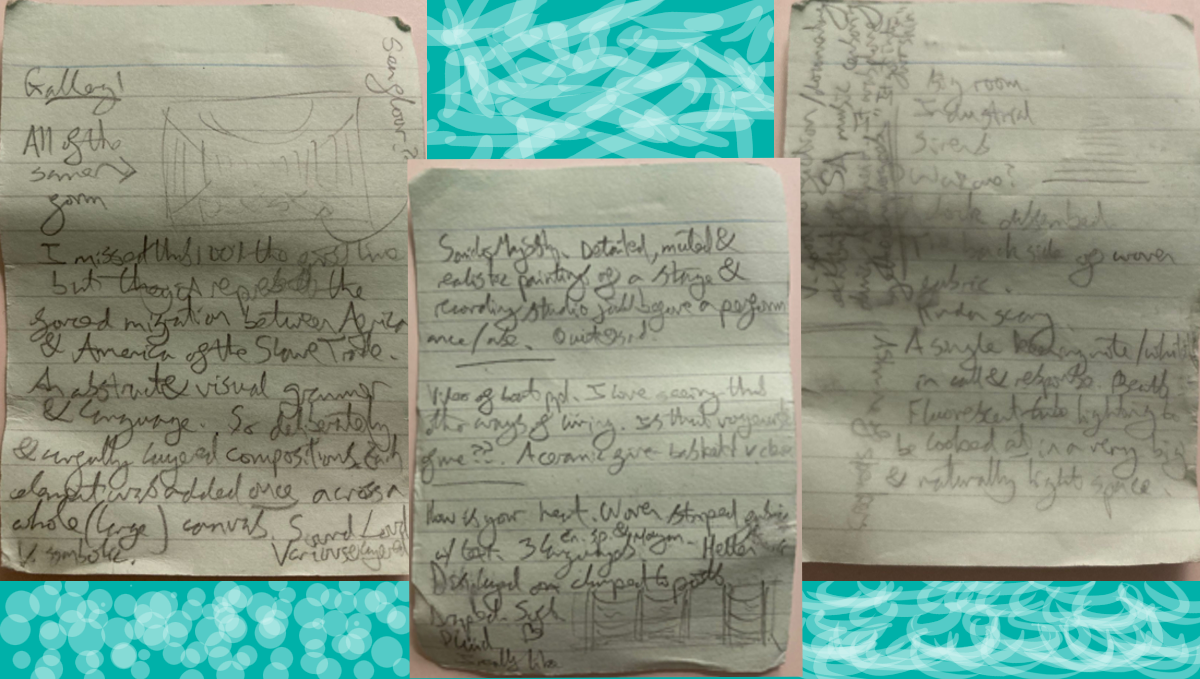We are super lucky to have a fantastic free art gallery (amongst other things) here in Nottingham. Nottingham Contemporary who have a regular schedule of fantastic exhibitions from global artists, and lots of other events (which I don't tend to go to, to be honest), and a really interestingly designed website. I hope they don't replace it with something more boring.
The current exhibitions are very good, especially PRISONERS OF LOVE: UNTIL THE SUN OF FREEDOM by BASEL ABBAS & RUANNE ABOU-RAHME which I may write about later, or I may not. This is about the last one I saw, which was called uhh... I didn't write that down, it was called YOUR EARS WILL LATER LEARN TO LISTEN. Okay here's what I thought of it:
YOUR EARS WILL LATER LEARN TO LISTEN
Firstly, what a fantastic title. Very good mouth-feel. This was a group exhibition with a vague theme of audio... stuff.
Gallery 1
In gallery 1 we had a collection of paintings by Satch Hoyt, which had been painted over many many years. They were really cool, I thought. They were kind of abstract, large canvases which all clearly had a shared symbolic grammar. They were all variations on hemisphere on the left, hemisphere on the right, sometimes one above and another below. There are vertical lines striping across, left to right. Like | | | | |. There are other lines crossing from left/right to right/left, and spheres floating in and amongst them. The colours are bright, and kind of washed out. The lines are varyingly textured, but precise and contrasting. The layering of elements is also very deliberate, and if you look and think about the order things must have been painted, you realise how extensively thought-through these pieces are.
The first time, I looked without reading the notes and I thought it had something to do with being a visual score of the music they were playing on the speakers. One piece was that, but actually they are abstract/spiritual illustrations of the transatlantic slave trade. Africa/America, shipping lines, heaven/hell/the sky/the seafloor. I think. I'm writing a lot of this from memory. I think that visual grammar/symbolism is really cool, and sustained over so many years, over such large canvases produces a really compelling body of work. Neat!
Gallery 2
This gallery had quite a few artists, and I don't really want to copy out all of their names and like, it's on the website. This is about what I thought and felt... Well, on the whole I thought and felt that these pieces were weaker. They didn't resonate as much with me. The exception was the piece called HOW IS YOUR HEART by HELLEN ASCOLI which was a series of large woven fabrics with various phrases in Mayan and English woven in as a form of recording. They looked really cool, and I love textiles, and South America and so yeah. Lots of things I like. It was fun to look at and think about it. Heartbeat in the sounds of weaving, weaving to record an endangered language, a greeting ('como está tu corazón') shared between the weavers that also invites introspection. Lovely.
Gallery 3
This gallery was also a mixed bag. Large video installation which I mostly ignored, sorry. Other than Hoyt's paintings, the other hightlight for me was a project that was a vinyl re-issue of records that had been censured by the South African state broadcaster during apartheid. The records were censured for a variety of reasons, though interestingly and importantly, there was not a strict government policy of what should be censured. Archivists and administrators just understood "what kind of thing" would be looked down on, and what they should censure. c/o Ada Palmer's work on cesorship being mostly a voluntary procedure. The records themselves are unremarkable, but kinda groovy. Some interesting interviews with the people who destroyed/censored the originals, by scrating over them with a pin and so on.
Also in this gallery, in the large turbine hall-like space they have was a big installation by a local artist that tried to combine the dilapidation and fading industrial heritage of where he now lived with the authoritarian Syrian state they had fled to get there (I think I have that right). There was a massive triangle of slats going up one wall, a partially disembled takeaway sign, tannoy speakers blaring a siren, that kind of thing. It was fairly impressive. Made sparse but effective use of the space, and definitely created a particular kind of feeling. A keening uneasiness? Hopefully they do more!
Finally there was a cool archiving/history project that was Taiwanese sugarcane workers' songs written during a 1925 uprising against the Japanese collonisers. It was a fairly cool movement historically, and this was an interesting project with modern-day sugarcane workers to resurrect the song and invent new melodies with the words. Very low-tech, just the artist with a guitar and a table of workers singing from sheets. I always like this kind of thing.
Okay that's it, I can throw away the paper notes I made now.
